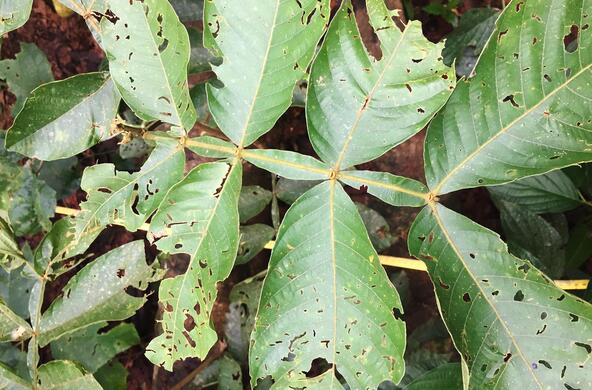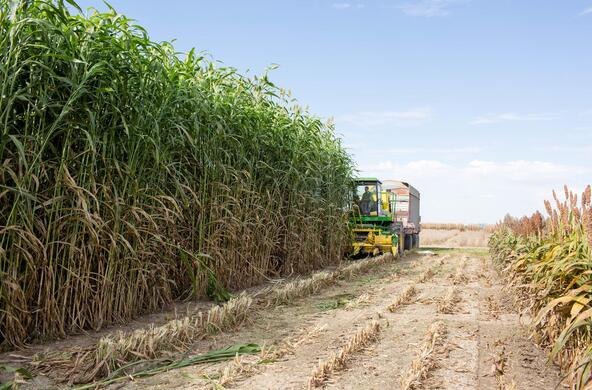Recognizing its utility as a household cleaner, especially to remove grease, ammonia has a smell that is familiar to most of us. But, nearly all of the annual industrial production of ammonia goes into other products, especially nitrogen fertilizer. Some farms inject ammonia directly into the soil. Others apply urea or ammonium phosphate fertilizers made from ammonia. All aim to supplement the availability of nitrogen for crop growth. Not all the ammonia gets into the crop. Inadvertent losses of nitrogen from fertilizers to the atmosphere account for about ten percent of fertilizer applications across the USA. Some nitrogen is also lost in the runoff to streams and rivers.
Nitrogen in agricultural crops that are fed to animals, especially hogs and poultry, is primarily released back to the environment as ammonia gas. The urine of mammals contains urea, which is converted to ammonia by bacteria in soils and hog-waste lagoons. The feces of chickens and turkeys contain uric acid, which also returns to the atmosphere as ammonia. Some of the highest concentrations of ammonia in rainfall occur in Iowa and eastern North Carolina, where a lot of these animals are grown.
Before it returns to the ground in rain, ammonia gas in the atmosphere reacts with sulfuric or nitric acid vapors to form small particles known as aerosols, which are largely composed of ammonia sulfate. Because they form in the atmosphere, these are known as “secondary aerosols.” (Soil dust would be an example of a primary aerosol). Secondary ammonia sulfate aerosols are very small, so they fall into the designation as PM2.5 —a category that is used to designate particulate matter that is less than 2.5 microns in diameter.
Fine particulate matter in each breath we take passes deep into our lungs, often lodging there. It exacerbates many respiratory diseases, such as asthma, emphysema, and COPD. Worldwide, fine particulate matter is the cause of 3 million deaths each year. In North Carolina, reductions in fine particulate matter are associated with healthier populations across the state.
One advantage of regulating the emissions of SO2 and NOx from coal-fired power plants is that there are lower concentrations of these acid-forming gases in the atmosphere, and thus lower formation of ammonium sulfate (and nitrate) aerosols.
That brings us to agriculture. At the moment, the Environmental Protection Agency does not recognize ammonia as an air pollutant. In rural areas, fine particles of ammonium sulfate dominate the total atmospheric burden of aerosols. Ammonia is unregulated, yet it is the cause of poor health and early death in rural agricultural communities. We often think of air pollution as a problem of industry and automobiles, but if you visit a region that has a lot of agricultural activity—fertilized farm fields or animals—don’t go there for the clean air. The problem extends regionally. At least one study has estimated that much of the economic benefit of using fertilizers in farms of the Midwest is negated by increased health costs due to particulate matter in the eastern U.S.
As we ramp up agricultural production to feed the world’s growing population, and its greater demand for meat protein, we are going to have to face up to ammonia as an air and water pollutant. Forms of reduced nitrogen, such as ammonia, are increasing in the atmosphere and rainfall. There are practices that can reduce ammonia emissions from farm fields and animal wastes. How and when we apply fertilizers and how we store animal waste (e.g., field applications vs. lagoons) can make a huge difference to ammonia emissions and better health for the people exposed to them.
Whether farmers will implement these practices on their own, or to comply with potential regulations, is unknown. But, I will note that one role of government is to ensure a healthy environment for all of us.
References
Aneja, V.P., P. A. Roelle, G. C. Murray, J. Southerland, J. W. Erisman, D. Fowler, W. A. H. Asman, and N. Patni, 2001, Atmospheric nitrogen compounds II: Emissions, transport, transformation, deposition and assessment. Atmospheric Environment 35: 1903-1911.
Aneja, V.P., D.R. Nelson, P.A. Roelle, J.T. Walker and W. Battye. 2003. Agricultural ammonia emissions and ammonium concentrations associated with aerosols and precipitation in the southeast United States. Journal of Geophysical Research 108: doi:10.1029/2002JD002271.
Kravchenko. J., I. Akushevich, A.P. Abernethy, S. Holman, W.G. Ross, and H.K. Lyerly. 2014. Long-term dynamics of death rates of emphysema, asthma, and pneumonia and improving air quality. International Journal of COPD 9: 613-627.
Leifer, I. and 12 others. 2017. Remote sensing and in situ measurements of methane and ammonia emissions from a megacity dairy complex, Chino, CA. Environmental Pollution 221: 37-51.
Lelieveld, J., J.S. Evans, M. Fnais, D. Giannadaki and A. Pozzer. 2015. The contribution of outdoor air pollution sources to premature mortality on a global scale. Nature 525: 367-371.
Li, Y., and 8 others. 2016. Increasing importance of deposition of reduced nitrogen in the United States. Proceedings of the National Academy of Science doi: 10.1073/pnas.1525736113
Paulot, F. and D.J. Jacob. 2014. Hidden cost of U.S. agricultural exports: Particulate matter from ammonia emissions. Environmental Science and Technology 48: 903–908.
Schlesinger, W.H. and A.E. Hartley. 1992. A global budget for atmospheric NH3. Biogeochemistry 15: 191-211.
Walker, J.T., D.R. Whitall, W. Robarge, and H.W. Paerl. 2004. Ambient ammonia and ammonium aerosol across a region of variable ammonia emission density. Atmospheric Environment 38: 1235-1246.
Warner, J.X., R.R. Dickerson, Z. Wei, L.L. Stow, Y. Wang, and Q. Liang. 2017. Increased atmospheric ammonia over the world’s major agricultural areas detected from space. Geophysical Research Letters 44: 2875-2884.







